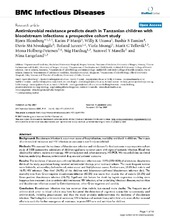| dc.description.abstract | Background: Bloodstream infection is a common cause of hospitalization, morbidity and death in children. The impact of antimicrobial resistance and HIV infection on outcome is not firmly established. Methods: We assessed the incidence of bloodstream infection and risk factors for fatal outcome in a prospective cohort study of 1828 consecutive admissions of children aged zero to seven years with signs of systemic infection. Blood was obtained for culture, malaria microscopy, HIV antibody test and, when necessary, HIV PCR. We recorded data on clinical features, underlying diseases, antimicrobial drug use and patients' outcome. Results: The incidence of laboratory-confirmed bloodstream infection was 13.9% (255/1828) of admissions, despite two thirds of the study population having received antimicrobial therapy prior to blood culture. The most frequent isolates were klebsiella, salmonellae, Escherichia coli, enterococci and Staphylococcus aureus. Furthermore, 21.6% had malaria and 16.8% HIV infection. One third (34.9%) of the children with laboratory-confirmed bloodstream infection died. The mortality rate from Gram-negative bloodstream infection (43.5%) was more than double that of malaria (20.2%) and Gram-positive bloodstream infection (16.7%). Significant risk factors for death by logistic regression modeling were inappropriate treatment due to antimicrobial resistance, HIV infection, other underlying infectious diseases, malnutrition and bloodstream infection caused by Enterobacteriaceae, other Gram-negatives and candida. Conclusion: Bloodstream infection was less common than malaria, but caused more deaths. The frequent use of antimicrobials prior to blood culture may have hampered the detection of organisms susceptible to commonly used antimicrobials, including pneumococci, and thus the study probably underestimates the incidence of bloodstream infection. The finding that antimicrobial resistance, HIV-infection and malnutrition predict fatal outcome calls for renewed efforts to curb the further emergence of resistance, improve HIV care and nutrition for children. | en_US |
